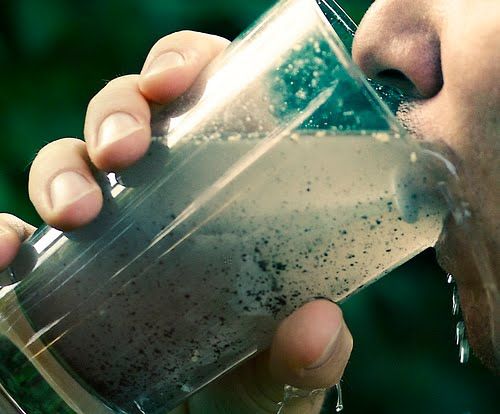That widespread use of the weed killer has also led to runoff. Atrazine can end up in lakes, streams and sometimes in drinking water.
"Atrazine is the number one contaminant found in drinking water in the U.S. and probably globally probably in the world", says University of California Berkeley, scientist Tyrone Hayes.
Comment: Read more about Dr. Tyrone Hayes: The scientist who took on a leading herbicide manufacturer:
The Frog of War
Silencing the Scientist: Tyrone Hayes on being targeted by herbicide firm Syngenta
Health Canada is aware that atrazine can make its way into drinking water. According to the agency, "because atrazine has been classified in Group III (possibly carcinogenic to humans)" an acceptable amount in drinking water has been set at 5 parts per billion. In the United States, the level has been set at 3 parts per billion.
That means as long as the amount of atrazine stays below that limit, Health Canada believes it is safe for human consumption.
Atrazine levels in drinking water vary in different regions of the country and during different times of the year. For example, in areas where there are more corn crops and greater application of the pesticide there is the potential for higher runoff.
According to Health Canada, "in areas where atrazine is used extensively, it (or its dealkylated metabolites) is one of the most frequently detected pesticides in surface and well water. Atrazine contamination has been reported in British Columbia, Nova Scotia, Prince Edward Island, Quebec, Ontario and Saskatchewan."
Atrazine is manufactured by Syngenta, the world's largest agribusiness. The European Union removed atrazine from the market in 2004.
In 2012, as part of a class action lawsuit settlement, Syngenta paid $105 million to more than 1000 municipal water systems in the U.S. to help pay for the removal of atrazine from drinking water. Syngenta denies any liability.
There is a lot of research examining amphibian and wildlife exposure to atrazine.
"Atrazine is probably the most well studied pesticide on the planet," says University of South Florida professor Jason Rohr, "perhaps only rivaled by DDT."
But there is less information about atrazine and human health. Some studies suggest a possible association between atrazine and ovarian, breast and prostate cancers and birth defects including smaller male genitals and gastroschisis (a congenital birth defect in the abdominal wall, in which the baby's intestines can be outside the belly).
"So for humans there are studies showing a correlation between atrazine exposure and low sperm count or low fertility, increased risk of breast cancer, increased risk of prostate cancer, deformities of the genitals", says Hayes.
Syngenta, the manufacturer of atrazine, says these studies regarding humans that cite risks or potential risks are scientifically flawed, and that other experts have reviewed the research and say it's unreliable. Syngenta reaffirms that Atrazine is safe, and approved for use by Health Canada and the United States Environmental Protection Agency.
"Regarding other impacts of atrazine, the EPA stated very clearly in its presentation to the July 2011 Scientific Advisory Panel that the available data do not support any association between atrazine exposure and cancer", Ann Bryan, Senior Manager for Syngenta, told 16×9, in a statement.
That same advisory panel to the EPA criticized the Agency for putting all cancers into one category in its atrazine assessment. "It would be useful and appropriate to make conclusions for individual cancers as opposed to making a blanket determination for cancer in general." It then provided a list of cancers with "suggestive evidence of carcinogenic potential": ovarian cancer, non-Hodgkin's lymphoma, hairy-cell leukemia, and thyroid cancer. The panel recommended follow-up studies.
Filtering out atrazine?
What can you do if you are concerned about atrazine in your drinking water? Check with your local water provider to see if it monitors and tests atrazine and how often. Also, you can purchase a home water filtration system that will remove atrazine from your water.
Water monitoring
In Canada, the federal government sets the guidelines for the acceptable limit of atrazine in water, and then the provincial governments establish the regulation and municipalities and local public health offices and agencies are responsible for monitoring and reporting. It can be complicated, the Canadian Council Canadian Council of Ministers of the Environment explains the system this way:
"In Canada, water quality monitoring is carried out within partnerships amongst provincial, territorial, and federal governments, municipalities, universities, water associations, environmental groups and volunteers. In general, provinces conduct much of the water quality monitoring within their boundaries. The federal government's monitoring focuses on inter-provincial and international boundary waters (e.g., Great Lakes) and other areas of federal authority (i.e., Territories, National Parks, and other federal lands). Monitoring of recreational waters is generally carried out by local municipalities. Monitoring of tap water, delivered through municipal supply systems, is also usually undertaken by local municipalities, often in partnership with provincial agencies."




Comment: More Stark Evidence of the Hazards of Atrazine:
Debating How Much Weed Killer Is Safe in Your Water Glass
Human Study Shows Atrazine Associated with Risk of Small Babies
EPA Fails To Inform Public About Weed-Killer In Drinking Water
Atrazine in Water Tied to Menstrual Irregularities, Low Hormones
Atrazine Threat to Male Sexual Development Revealed
Atrazine Pesticide Causes Birth Defects
Revealed: How Syngenta Investigated the Press and Shaped the News About its Controversial Weed-Killer Atrazine